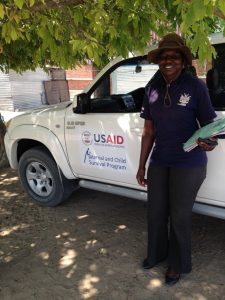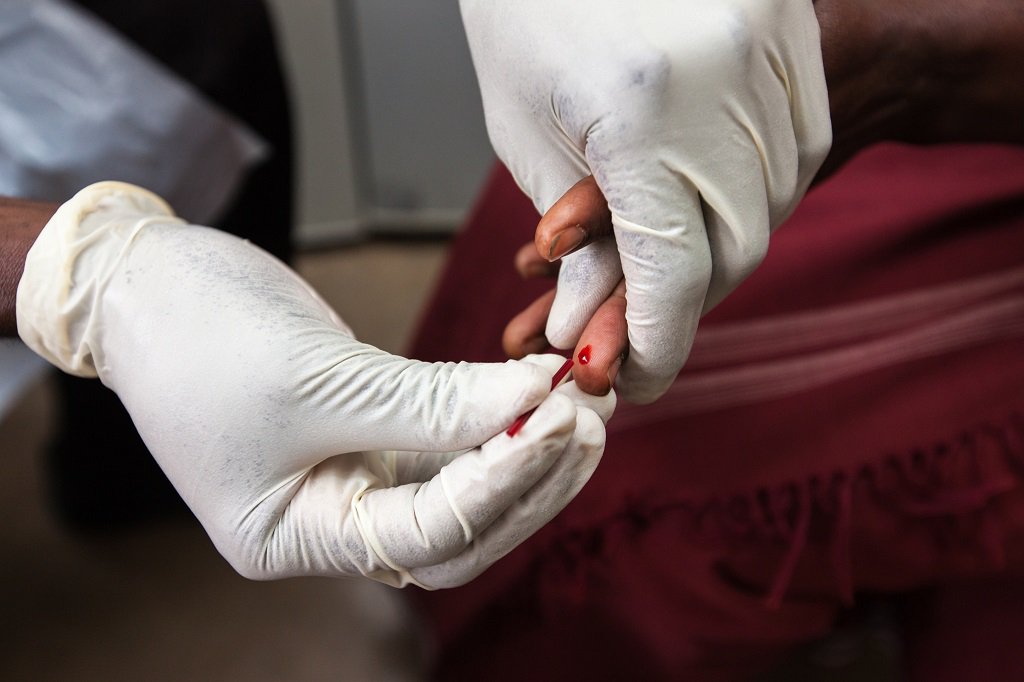As morbidities associated with immunosuppression have made HIV/AIDS a leading causes of death in Namibia, testing for HIV has become a lifesaving intervention. However, a human resource crisis in the country — coupled with the fact that many Namibians live in isolated, hard-to-reach communities — are keeping rates of routine HIV testing in the country low.
In response, MCSP is implementing a multi-faceted project to help the Ministry of Health and Social Services deliver community-based HIV testing and counseling (HTC) through the national Health Extension Program (HEP). Beginning in July 2016, the HEP pilot program rolled out HIV rapid test training to 60 health extension workers (HEWs) at three clinics in the Engela district of northern Namibia.
One such HEW, 38-year-old Bernadine, has already tested hundreds of clients in her community for HIV — more, in fact, than any other trained HEWs conducting community-based HTC. In addition, most of the individuals she tested who proved positive for HIV have also been successfully linked to care and initiated on antiretroviral treatment (ART).
To better understand how Bernadine’s successes in the field might be applied to other field sites and adopted by more HEWs, a case study was conducted examining her current life, upbringing, and outlook. She revealed that her passion for helping others began long before her career as a HEW. As a young girl in school, she dreamed of becoming a nurse; at home, she was often the caretaker.
In a previous position, she volunteered with the elderly and helping people living with HIV to help with personal projects. After studying health at Good Samaritan College, she began her work as a HEW.

“When I saw the advert [to become a HEW], I knew this was my job because I had the heart to do it,” she said.
Despite never having conducted a HIV rapid testing prior to the training, integrating HTC into her established role as a HEW made her job easier, she said. In the past, when she screened and referred clients to the clinic for tuberculosis, some returned with a negative tuberculosis result, but a persistent cough. Now, she can test her clients for HIV, as well, putting her in a better position to serve their needs.
And by listening to her clients and providing them with information about HTC and treatment, she said their initial fear of testing dissipates. “Positive or negative, they feel free,” she said. “They accept their results.”
Bernadine’s scope of work encompasses three locations and 93 households. Misconceptions and stigma — especially surrounding taking medication — were pervasive. Index client testing also posed a challenge in the field. Testing the children and partners of clients who tested positive was difficult, because many contacts lived far away. Tracing these contacts was also complex, as many regularly crossed the border into Angola.
Bernadine encountered one mixed status couple (one partner infected by HIV; the other not) in her work. Both clients decided to test individually, and only told Bernadine of their relationship after they had both been tested. She counseled them individually, and referred the HIV positive client for ART.
In all, she encountered only one refusal. The man who did not want to be tested was a part of a couple; his wife did want to be tested. Bernadine was able to test all of their children for HIV; however, the wife declined to get tested without her husband.
The majority of Bernadine’s clients were in their 20s and 30s, and did not have a high perceived personal risk for HIV. After counseling, many changed their minds and asked to be tested.
Providing accurate information is very important to proper HTC, Bernadine stressed, as is counseling men. Generally, she found men needed more time to decide if they would be tested than women did. In her pre-test counseling, she always explained the implications of a positive test, preparing her clients for either result.
None of those who tested positive were visibly sad or depressed by their results, Bernadine reported. She counseled them and supported them with important information about how and where to access ART services, how to visit the hospital, and the importance of safe sex.
Bernadine’s successes could be attributed her strong work ethic as well as the higher prevalence of HIV in her coverage area. Even when she lacks adequate supplies for rapid testing, she still counsels her clients on HIV testing to increase the chances they will accept HTC the next time she visits. Others conducting community-based HTC could learn from her patience with her clients and her pre-test counseling, which ensures that clients are prepared for their results and successfully linked to care.

